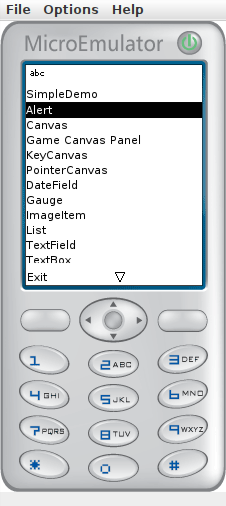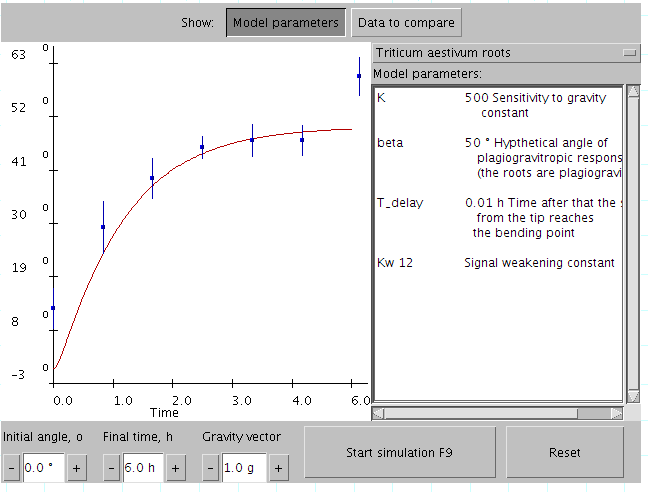|
MIDlet
A MIDlet is an application that uses the Mobile Information Device Profile (MIDP) of the Connected Limited Device Configuration (CLDC) for the Java ME environment. Typical applications include games running on mobile devices such as smartphones with J2ME support and feature phones which have small graphical displays, simple numeric keypad interfaces and limited network access over HTTP. The .jad file describing a MIDlet suite is used to deploy the applications in one of two ways. Over the air (OTA) deployment involves uploading the .jad and .jar files to a Web server which is accessible by the device over HTTP. The user downloads the .jad file and installs the MIDlets they require. Local deployment requires that the MIDlet files be transferred to the device over a non-network connection (such as through Bluetooth or IrDa, and may involve device-specific software). Phones that support microSD cards can sometimes install .jar or .jad files that have been transferred to the memory car ... [...More Info...] [...Related Items...] OR: [Wikipedia] [Google] [Baidu] |
MicroEmulator
MicroEmulator (also MicroEMU) — is a Free and open-source software, free and open-source Cross-platform software, platform independent J2ME emulator allowing to run MIDlets (applications and games) on any device with compatible JVM. It is written in pure Java as an implementation of J2ME in J2SE. History In November 2001, MicroEmulator project has been created on SourceForge. On 31 March 2006, MicroEmulator version 1.0 has been released. In November 2009, project moved to code.google.com, and after Google closed it, development moved to GitHub. On 10 January 2010, the last stable version 2.0.4 has been released. On 24 May 2013, the last preview version 3.0.0-SNAPSHOT.112 has been released. After 2014, MicroEMU technology has been acquired by All My Web Needs company and all the MicroEmulator's docs and binary builds has been removed from the official site. All sources and binary previously released on SourceForge, Google Code and GitHub preserved as open-source, but deve ... [...More Info...] [...Related Items...] OR: [Wikipedia] [Google] [Baidu] |
Series 40
Nokia Series 40 Platform, often shortened as S40, is a software platform and application user interface (UI) software that was previously used on Nokia's broad range of mid-tier feature phones from 2002 to 2014, as well as on some of the Vertu line of luxury phones. It was at one point the world's most widely used mobile phone platform and found in hundreds of millions of mobile phones. Series 40 was more advanced than Nokia's Series 30. It was not however used for smartphones (where Nokia used Symbian at the time, and later Windows Phone) and differentiates from them by not supporting true multi-tasking and do not have a native code API for third parties and thus do not support installable applications other than (with few exceptions) MIDlets that are written in Java. However, the simplicity of the system made it more responsive compared to Nokia's Series 60 smartphones. The final Series 40 phone was released in 2013, after which Nokia feature phones switched to a different ... [...More Info...] [...Related Items...] OR: [Wikipedia] [Google] [Baidu] |
LCDUI
Mobile Information Device Profile (MIDP) is a specification published for the use of Java on embedded devices such as mobile phones and PDAs. MIDP is part of the Java Platform, Micro Edition (Java ME) framework and sits on top of Connected Limited Device Configuration (CLDC), a set of lower level programming interfaces. MIDP was developed under the Java Community Process. The first MIDP devices were launched in April 2001. General APIs The core application programming interfaces are defined by the underlying Connected Limited Device Configuration system. javax.microedition.io Contains the Java ME-specific classes used for I/O operations. javax.microedition.lcdui Contains the Java ME-specific classes used for the GUI. LCDUI has a simple screen based approach where a single Displayable is always active at anyone time in the application user interface. LCDUI API provides a small set of displayables common in mobile device user interfaces: List, Alert, TextBox, Form and C ... [...More Info...] [...Related Items...] OR: [Wikipedia] [Google] [Baidu] |
Connected Limited Device Configuration
The Connected Limited Device Configuration (CLDC) is a specification of a framework for Java ME applications describing the basic set of libraries and virtual-machine features that must be present in an implementation. The CLDC is combined with one or more profiles to give developers a platform for building applications on embedded devices with very limited resources such as pagers and mobile phones.CLDC Overview http://java.sun.com/javame/technology/cldc/overview.jsp The CLDC was developed under the Java Community Process as JSR 30JSR 30, CLDC 1.0 http://www.jcp.org/en/jsr/detail?id=30 (CLDC 1.0) and JSR 139JSR 139, CLDC 1.1 http://www.jcp.org/en/jsr/detail?id=139 (CLDC 1.1). Typical requirements CLDC is designed for devices that have limited processing power, memory, and graphical capability. Devices typically have the following features: * 16- bit or 32-bit CPU with a clock speed of 16 MHz or higher * At least 160 KB ROM allocated for the CLDC libraries and virtu ... [...More Info...] [...Related Items...] OR: [Wikipedia] [Google] [Baidu] |
Java ME
Java Platform, Micro Edition or Java ME is a computing platform for development and deployment of porting, portable code for embedded system, embedded and mobile devices (micro-controllers, sensors, gateways, mobile phones, personal digital assistants, TV set-top boxes, printers). Java ME was formerly known as Java 2 Platform, Micro Edition or J2ME. The platform uses the object-oriented programming, object-oriented java (programming language), Java programming language, and is part of the Java (software platform), Java software-platform family. It was designed by Sun Microsystems (now Oracle Corporation) and replaced a similar technology, PersonalJava. In 2013, with more than 3 billion Java ME enabled mobile phones in the market, the platform was in continued decline as smartphones have overtaken feature phones. History The platform used to be popular in feature phones, such as Nokia's Series 40 models. It was also supported on the Bada (operating system), B ... [...More Info...] [...Related Items...] OR: [Wikipedia] [Google] [Baidu] |
Sony Ericsson Java Platform
The Sony Ericsson Java Platform is a set of profiles describing particular Sony Ericsson Java implementation. It was designed to help developers to focus on a platform rather than on a variety of different product names. Two platform branches exist, supporting Symbian (SJP) and non-Symbian (JP) based phones respectively. The platforms are implemented through an evolutionary approach in order to ensure forwards compatibility between platform versions, which means that all JSRs (except the optional) implemented on one platform are also implemented on all higher platforms. Normally each platform version is used in several phone models. Some platform features are optional, that is, configurable. For example, the Java Bluetooth APIs (JSR 82) are only enabled for phones which actually support Bluetooth Bluetooth is a short-range wireless technology standard that is used for exchanging data between fixed and mobile devices over short distances and building personal area networks ... [...More Info...] [...Related Items...] OR: [Wikipedia] [Google] [Baidu] |
Swing (Java)
Swing is a Graphical user interface, GUI widget toolkit for Java (programming language), Java. It is part of Oracle Corporation, Oracle's Java Foundation Classes (JFC) – an Application programming interface, API for providing a graphical user interface (GUI) for Java programs. Swing was developed to provide a more sophisticated set of GUI Software component, components than the earlier Abstract Window Toolkit, Abstract Window Toolkit (AWT). Swing provides a look and feel that emulates the look and feel of several platforms, and also supports a pluggable look and feel that allows applications to have a look and feel unrelated to the underlying platform. It has more powerful and flexible components than AWT. In addition to familiar components such as buttons, check boxes and labels, Swing provides several advanced components such as tabbed panel, scroll panes, trees, tables, and lists. Unlike AWT components, Swing components are not implemented by platform-specific code ... [...More Info...] [...Related Items...] OR: [Wikipedia] [Google] [Baidu] |
Abstract Window Toolkit
The Abstract Window Toolkit (AWT) is Java's original platform-dependent windowing, graphics, and user-interface widget toolkit, preceding Swing. The AWT is part of the Java Foundation Classes (JFC) — the standard API for providing a graphical user interface (GUI) for a Java program. AWT is also the GUI toolkit for a number of Java ME profiles. For example, Connected Device Configuration profiles require Java runtimes on mobile telephones to support the Abstract Window Toolkit. History When Sun Microsystems first released Java in 1995, AWT widgets provided a thin level of abstraction over the underlying native user-interface. For example, creating an AWT check box would cause AWT directly to call the underlying native subroutine that created a check box. However, the check box on Windows is not the same as the check box on macOS or on the various types of Unix. Some application developers prefer this model because it provides a high degree of fidelity to the underlying ... [...More Info...] [...Related Items...] OR: [Wikipedia] [Google] [Baidu] |
Java Applet
Java applets were applet, small applications written in the Java (programming language), Java programming language, or another programming language that Compiled language, compiles to Java bytecode, and delivered to users in the form of Java bytecode. At the time of their introduction, the intended use was for the user to launch the applet from a web page, and for the applet to then execute within a Java virtual machine (JVM) in a Process (computing), process separate from the web browser itself. A Java applet could appear in a frame of the web page, a new application window, a program from Sun Microsystems, Sun called appletviewer, or a stand-alone tool for testing applets. Java applets were introduced in the first version of the Java language, which was released in 1995. Beginning in 2013, major web browsers began to phase out support for NPAPI#Support/deprecation, NPAPI, the underlying technology applets used to run. with applets becoming completely unable to be run by ... [...More Info...] [...Related Items...] OR: [Wikipedia] [Google] [Baidu] |
Android (operating System)
Android is an operating system based on a modified version of the Linux kernel and other open-source software, open-source software, designed primarily for touchscreen-based mobile devices such as smartphones and tablet computer, tablets. Android has historically been developed by a consortium of developers known as the Open Handset Alliance, but its most widely used version is primarily developed by Google. First released in 2008, Android is the world's Usage share of operating systems, most widely used operating system; the latest version, released on June 10, 2025, is Android 16. At its core, the operating system is known as the Android Open Source Project (AOSP) and is free and open-source software (FOSS) primarily licensed under the Apache License. However, most devices run the proprietary software, proprietary Android version developed by Google, which ships with additional proprietary closed-source software pre-installed, most notably Google Mobile Services (GMS), which ... [...More Info...] [...Related Items...] OR: [Wikipedia] [Google] [Baidu] |





